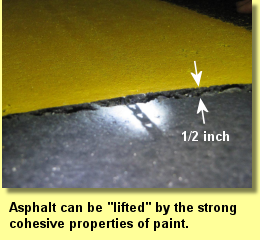 |
 |
Painting AsphaltBy Donna SpeidelThere's a new kid on the block in the waterborne traffic paint world. It's not really new; the paint chemists have been developing the material for several years to compete with other durable highway marking products such as epoxy, thermoplastics, etc. The FAA approved its use on airfields in 2009; but it needs more of an introduction than simply appearing in the FAA AC 150/5370-10F, Item P620 specification for Airfield and Taxiway Painting. So please meet Federal Specification TT-P-1952E, Type III waterborne paint. It is marketed as "High-Build" paint which refers to the designed application rate of 25 to 30 mils wet film thickness which would correlate to 75 to 60 square feet per gallon. At that thickness, the more commonly used Type I or Type II waterborne paints would crack. But the patented resin, HD21A, in the High Build product results in a more flexible cured coating, which when applied at a thicker rate competes with other durable highway coatings.
Asphalt pavements are susceptible to cracking from the use of solvent or standard (Type I, II) waterborne paints, because the paint bonds better to the asphalt than the asphalt does to itself. When the markings absorb water, they expand; when they dry, they contract; but at a different rate than the underlying asphalt. The more flexible Type III formulation moves better with the asphalt, thus reducing the incidence of cracking; perhaps its greatest asset.
If you have an upcoming striping project that involves applying paint to new/old asphalt pavement, I strongly suggest revisiting your specifications to include the Type III paint. It may be a bit more expensive (up to $4.00 per gallon more), but that translates into about $.04 per square foot. We believe the additional cost is well worth the benefit the airport can realize. There are several other provisions we include in Sightline specifications for asphalt projects, but not enough room here to name them all. But feel free to email me and I'll be happy to discuss. |

 Whereas materials such as epoxy and methyl methacrylate, also approved for use on airfields by the FAA, may not have
favorable results on asphalt runway surfaces, they can have utility on other markings on an airport. However, the Type III paint used at
thicker applications performs well on either asphalt or concrete, on runways, taxiways, aprons, and gate areas.
Whereas materials such as epoxy and methyl methacrylate, also approved for use on airfields by the FAA, may not have
favorable results on asphalt runway surfaces, they can have utility on other markings on an airport. However, the Type III paint used at
thicker applications performs well on either asphalt or concrete, on runways, taxiways, aprons, and gate areas.
 Further, the Type III can also be applied at the standard 15 mils wet film thickness (115 square feet per gallon) that
corresponds to the coverage rates of the other approved waterborne paint types. So even though it can be applied thicker, it can also be
applied at lesser rates and still reduce the likelihood of cracking underlying asphalt. As a result, the Type III allows applicators more
latitude during installation. Keep in mind, the thicker the paint is applied, the longer the paint needs to cure.
Further, the Type III can also be applied at the standard 15 mils wet film thickness (115 square feet per gallon) that
corresponds to the coverage rates of the other approved waterborne paint types. So even though it can be applied thicker, it can also be
applied at lesser rates and still reduce the likelihood of cracking underlying asphalt. As a result, the Type III allows applicators more
latitude during installation. Keep in mind, the thicker the paint is applied, the longer the paint needs to cure.